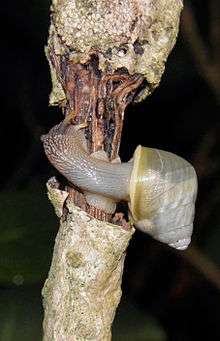Amphidromus inversus
| Amphidromus inversus | |
|---|---|
 | |
| juvenile Amphidromus inversus | |
| Scientific classification | |
| Kingdom: | Animalia |
| Phylum: | Mollusca |
| Class: | Gastropoda |
| (unranked): | clade Heterobranchia clade Euthyneura clade Panpulmonata clade Eupulmonata clade Stylommatophora informal group Sigmurethra |
| Superfamily: | Helicoidea |
| Family: | Camaenidae |
| Subfamily: | Camaeninae |
| Genus: | Amphidromus |
| Subgenus: | Amphidromus |
| Species: | A. inversus |
| Binomial name | |
| Amphidromus inversus O. F. Müller, 1774 | |
Amphidromus inversus is a species of air-breathing land snail, a terrestrial pulmonate gastropod mollusk in the family Camaenidae. Like most members of the subgenus Amphidromus, it is chirally dimorphic: within the same populations, both dextral (clockwise-coiled) and sinistral (anticlockwise-coiled) individuals co-exist. This is one of the very few cases of genetic antisymmetry known in nature. Among the subgenus Amphidromus, A. inversus stands out because since c. 2004, it has been the focus of studies aimed at understanding the evolution of chiral dimorphism. Most of these studies have taken place on the Malaysian island of Kapas.
Subspecies
- Amphidromus inversus annamiticus
Distribution
Sumatra, Peninsular Malaysia, Thailand
Description
_(4248353502).jpg)
Ecology

Schilthuizen et al. (2005) described spatial structure of population of Amphidromus inversus in Malaysia.[1]
References
- ↑ Schilthuizen, M.; Scott, B. J.; Cabanban, A. S.; Craze, P. G. (2005). "Population structure and coil dimorphism in a tropical land snail". Heredity. 95 (3): 216–220. PMID 16077741. doi:10.1038/sj.hdy.6800715.
Further reading
- Schilthuizen, M.; Craze, P. G.; Cabanban, A. S.; Davison, A.; Stone, J.; Gittenberger, E.; Scott, B. J. (2007). "Sexual selection maintains whole-body chiral dimorphism in snails". Journal of Evolutionary Biology. 20 (5): 1941–1949. PMC 2121153
 . PMID 17714311. doi:10.1111/j.1420-9101.2007.01370.x.
. PMID 17714311. doi:10.1111/j.1420-9101.2007.01370.x. - Schilthuizen, M.; Looijestijn, S. (2009). "The Sexology of the Chirally Dimorphic Snail SpeciesAmphidromus inversus(Gastropoda: Camaenidae)". Malacologia. 51 (2): 379. doi:10.4002/040.051.0210.
- Sutcharit, C. (2006). "A new subspecies of Amphidromus (A.) inversus (Müller, 1774) from Peninsular Malaysia". Journal of Conchology. 39 (1): 79–83.
- (in Dutch) "Kurkentrekkers leiden tot slakken-seksschandaal". Naturalis (in Dutch). 19 June 2007.
External links
| Wikimedia Commons has media related to Amphidromus inversus. |